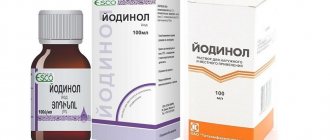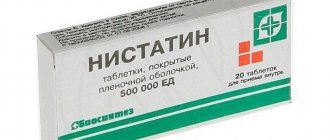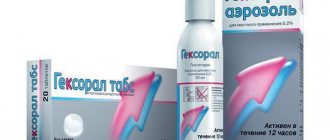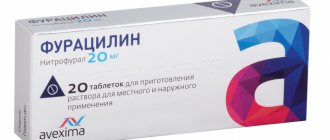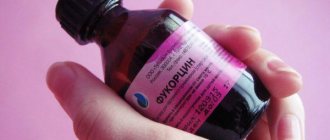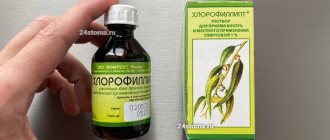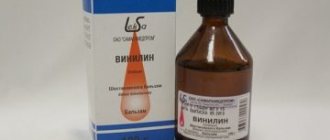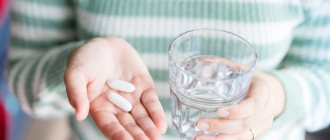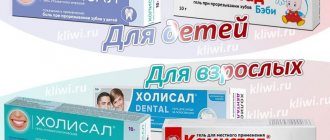Stomatitis is a common inflammatory disease that affects the oral mucosa. It appears as white sores that cover the tongue, gums, inner surface of the cheeks, lips and palate.
All age groups of the population are at risk, from newborns to the elderly.
Using Chlorophyllipt for treatment, you can relieve the symptoms of stomatitis within 10 days.
Chlorophyllipt alcohol - composition and indications
Chlorophyllipt is, first of all, an antimicrobial drug, but its destructive effect extends not only to pathogenic bacteria, but also to worms and parasites.
The active ingredient is eucalyptus extract, which has a strong antiseptic effect. The drug is merciless against staphylococci and other infectious bacteria, so it can be used to relieve any chronic and purulent inflammation in the body. Since this substance began to be used to treat tonsillitis, many patients have noted that it makes breathing easier. A unique drug is widely used in such fields of medicine as gynecology, dentistry, surgery, urology, gastroenterology, etc. Chlorophyllipt can have a beneficial effect on affected areas of the skin with burns, trophic ulcers, etc. The antimicrobial agent is often used to sanitize the oral cavity by representatives of the medical professions who have constant contact with staphylococcal infection. The drug allows patients to quickly cope with the infection, and also reduces pain, relieves inflammation and relieves a sore throat.
Indications for the use of the alcohol form are:
- angina;
- tonsillitis, pharyngitis, laryngitis;
- inflammatory processes in the throat caused by hypothermia, a cold or against the background of a viral infection;
- as a prophylactic agent after dental surgery.
Characteristics of the drug
Chlorophyllipt occupies one of the leading places in popularity among the population. The manufacturer offers a series of medications, each of which effectively fights various diseases of the mouth, nose and throat.
One of the advantages of the drug is its plant origin. With the correct dosage, the medicine has a bactericidal effect and also slows down the growth and reproduction of bacteria.
The medicine effectively copes with various types of coccal bacteria. Chlorophyllipt actively affects some staphylococci, which are resistant even to antibacterial drugs.
When using the medicine, the tissues are saturated with oxygen, and therefore there is less intoxication of the body. The safety of treatment is also enhanced by the fact that the drug is practically non-toxic and has minimal side effects.
Contraindications
Chlorophyllipt is generally not prescribed to patients with increased function of the glands of the digestive system and atrophy of the mucous surfaces. When using the product, do not allow it to come into contact with the eyes. Since Chlorophyllipt is a natural medicine, before use you should make sure that the patient is not allergic to the components. To do this, allergy tests are done on the mucous membrane.
The patient’s sensitivity to eucalyptus extract is also important. To check the reaction, you can drink a spoonful of the drug based on it, diluted in water. If allergy symptoms (itching, rash, redness of mucous membranes, nausea, vomiting, etc.) are not observed within seven hours, you can safely begin a course of treatment with Chlorophyllipt.
Limitations for use
The medicine should be used with caution by those people who are prone to allergic reactions. In some cases, after using the drug, skin itching, swelling of the throat mucosa, and rash are observed. If the dose is exceeded, vomiting, diarrhea, and nausea are possible.
Frequent use of the drug in the form of inhalations and rinses leads to thinning and dryness of the mucous membrane of the nose and mouth.
Among the contraindications:
- hypersensitivity to the components of the drug;
- atrophy of the mucous membranes;
- diseases of the gastrointestinal tract.
Adults are strictly not recommended to drink alcohol during treatment.
Cautions
A medicine based on eucalyptus extract must be taken with special caution in case of increased secretion of the digestive glands. When treating the affected area, you should be careful and prevent Chlorophyllipt from getting into your eyes, especially the alcohol solution. Before starting treatment for stomatitis with this medication, you must make sure that there is no allergic reaction to the components of the drug. To do this, do a test spray and monitor the reaction of the mucous membrane.
You can determine sensitivity to eucalyptus, the main component of the medicine, by drinking a spoonful of infusion made from five drops of eucalyptus tincture and a tablespoon of water. You should monitor the allergic reaction for 7 hours; if there are no manifestations, then you can begin the full course of treatment.
Side effects
After using Chlorophyllipt, the following side effects may be observed:
Negative effects from the use of Chlorophyllipt may include symptoms of poisoning and malaise.
- muscle tension;
- allergy;
- diarrhea;
- gagging;
- nausea;
- drying of the mucous membranes of the respiratory organs and oral cavity.
Let's sum it up
Thus, the drug helps:
- anesthetize damaged areas of the mucous membrane;
- disinfect wounds;
- regenerate affected areas and saturate with oxygen;
- cope with pathogenic flora.
Chlorophyllipt is a broad-spectrum antimicrobial and anti-inflammatory agent. Very effective for various ENT diseases. Suitable for use by both small children and adults. Thanks to its herbal composition, it has a minimum of contraindications and side effects.
Reviews and analogues
According to reviews from parents, Chlorophyllipt is a highly effective drug that helps not only with stomatitis, but also with sore throat, various skin lesions and many other problems.
As a rule, wounds and ulcers in the mouth completely disappear in just 3-4 days, which indicates a rapid onset of positive effects from treatment. The downside, according to reviews, is the pronounced taste and smell of eucalyptus, which sometimes children do not like. Analogues:
- Miramistin . An effective drug with a pronounced antiseptic and bactericidal effect. This product does not have a pronounced taste and smell, like Chlorophyllipt, however, and it costs several times more than the latter;
- Inhalipt . Another safe and proven medicine with virtually no contraindications;
- Chlorhexidine . This external antiseptic can also be used to rinse your mouth for stomatitis. Efficiency is high, and pain is relieved already on the second day from the start of using the product;
- Rotokan is a rinse based exclusively on herbal and safe ingredients;
- Furacilin . Tablet for 100-150 ml of water, used for rinsing.
You should consult your doctor about the advisability of using a particular remedy.
Use of Chlorophyllipt in dentistry
The medicine is actively used in surgery and gynecology, it eliminates diseases of the throat and nasopharynx. Dentists often recommend Chlorophyllipt for gums in situations that require keeping the mouth clean. This is an excellent composition for rinsing teeth in the following situations:
- gingivitis;
- ulcers due to stomatitis;
- inflammation in the intergingival spaces;
- performing dental surgery on the mucous membrane;
- installation of a prosthesis or screwing in an implant;
- inflammation after infection with staphylococcus.
- Hypertrophic gingivitis photo
- Hypertrophic gingivitis
- Herpetic stomatitis
- Allergic stomatitis in adults
- Herpetic stomatitis
- Allergic stomatitis photo
- Gingivitis photo
- Initial stage of gingivitis
As a prophylactic agent, Chlorophyllipt solution is used by patients whose immune system has failed after suffering from acute respiratory viral infections, laryngitis, tonsillitis or bacterial bronchitis. The drug helps prevent complications for people after chemotherapy or long-term antibiotic treatment.
Advantages of the drug
This is an affordable remedy that is not only inexpensive, but also available without a prescription. It effectively fights various inflammations of the mouth and throat.
The drug has few contraindications (however, prior consultation with a doctor is advisable, and during pregnancy, mandatory). The product allows you to quickly overcome a number of oral problems that would have been long and painful without the use of the drug.
The product belongs to antimicrobial drugs of plant origin. It has bactericidal, bacteriostatic and anti-inflammatory effects. It especially helps against staphylococci, including those strains of these microorganisms that are resistant to antibiotics.
How to use it correctly
The drug comes with detailed instructions that describe the algorithm from start to finish. First, get acquainted with the contraindications. They consist of hypersensitivity to components, including: eucalyptus leaf extract and sunflower oil.
According to the instructions for use, an allergic reaction is possible after using the medicine. If this happens, swelling of the larynx and difficulty breathing are possible, which is critical. That’s why it’s worth doing a test first.
To do this, take five drops per tablespoon of water. Dissolve. Rinse your mouth. Spit it out. Then they don’t eat or drink for half an hour. If there is a burning sensation, itching, redness of the mucous membrane and similar manifestations of allergies, take antihistamine tablets. It is clear that in this situation further use is unacceptable.
Local use. Rinse your mouth after eating. When rinsing the gums is finished, the drug must be spat out. The result will be if you rinse at least twice a day, but at the same time, you should not overuse it. It is not recommended to rinse more than four times a day.
There is a good reason why excessive rinsing with an alcohol solution of Chlorophyllipt is not advisable for gums. The point here is that such solutions, when abused, lead to dryness and thinning of the mucous membrane, which ultimately increases inflammation of the gums.
In addition, the solution will not help in every situation, since it is a relatively weak antiseptic. That is why in other cases it is better to consult a doctor. But there is also an oil solution and spray, which are also suitable for combating problems of the oral cavity, in particular for treating ulcers.
After tooth extraction
At the end of this operation, the mouth is disinfected. An alcohol solution is again suitable for these purposes. Dentists note that the product satisfactorily copes with sanitation.
Chlorophyllipt for rinsing the mouth after tooth extraction is a good solution to prevent infection of a vulnerable area after such a strong intervention in the body.
How to dilute as a mouth rinse for stomatitis?
You can use an alcohol solution of Chlorophyllipt for rinsing, however, not all experts recommend using it. The fact is that the product must be diluted with water; the concentration of the active substance decreases, which leads to a decrease in the antimicrobial effect. The presence of alcohol in the drug can have a detrimental effect on the mucous membranes of the oral cavity. Moreover, alcohol is able to dilate blood vessels, facilitating deeper penetration of the infection.
If you use Chlorophyllipt for a long period of time, you can provoke an increase in the inflammatory process of the gums. Motorists should completely refrain from rinsing with an alcohol solution!
For children
The product is not recommended for use before the age of 12, but can be used earlier - only according to the indications of a pediatrician. If there is an inflammatory process in the mouth of an infant, Chlorophyllipt in the form of oil is applied pointwise to the affected areas (using a cotton swab). A few drops of the alcohol form of the drug (1%), which is diluted in a glass of boiled water (breast milk or formula) at the rate of 1 drop = 1 year of life, can help cope with infection in children.
Older children already know how to rinse their mouths, so they can use an alcohol solution diluted in water to irrigate the mouth. Having diluted Chlorophyllipt at the rate of 1 tbsp. spoon in a glass of water, the child needs to rinse his mouth under the supervision of elders. The procedure should be carried out three times a day, each time using a fresh solution. Chlorophyllipt will relieve children from unpleasant sensations in the mouth and will have a mild antiseptic effect and relieve inflammation of the gums.
To achieve the desired effect, you need to rinse your mouth and adhere to the following recommendations:
- the child should take about half a sip into his mouth;
- tilting your head back, inhale through your nose;
- open the mouth slightly;
- pronounce a long vowel sound “a” (5-7 seconds is enough);
- spit out the solution, then repeat the procedure 10 more times.
For adults
In adults, the rinsing process is similar, only the solution must be prepared in a larger volume (250 ml) (for more details, see the article: rinsing the mouth for stomatitis in adults). It is necessary to use only a fresh solution, rinsing it completely, since during storage the healing properties of Chlorophyllipt dissolved in water fade away. When treating stomatitis, rinsing should be done for 10 minutes. after 30 minutes after eating. During the procedure, you cannot swallow the solution, and eating is possible only after an hour. Chlorophyllipt for stomatitis, according to the instructions for use, is used 4 times a day.
In cases of purulent inflammation of the throat, in particular sore throat, the concentration can be increased from 5 ml. up to 10 ml. alcohol solution per 250 ml. liquids. For sore throat, the number of rinses increases to 7 times a day.
Rinsing with medicinal solutions
An effective method of rinsing is the use of medications prescribed by the dentist.
Chlorhexidine
A 0.05% aqueous solution of chlorhexidine is used to rinse the mouth.
Directions for use: take 1 tablespoon of the product into your mouth, rinse for 1 minute 2 times a day (preferably morning and evening), about one hour before brushing your teeth.
Treatment time is no more than 10 - 12 days. The medicine is not diluted. You need to rinse continuously for a minute.
An excellent remedy that has high antimicrobial activity and copes well with painful sensations.
Miramistin
In dentistry, a 0.01% solution of miramistin is used for external use. The drug in this concentration is irrigated into the oral cavity 3-4 times a day. In this case, you should refrain from drinking and eating for 2 hours.
Important! The course of therapy is no more than seven days, continuation is only as prescribed by a doctor. Miramistin is an effective antiseptic that reduces the number of microorganisms and completely relieves inflammation, and therefore will help with pain
Miramistin is an effective antiseptic that reduces the number of microorganisms and completely relieves inflammation, and therefore will help with pain.
When can you rinse with Novocaine?
For pain relief, a medicinal solution is used with a percentage of anesthetic from 0.25% to 2% in ampoules or bottles.
To prepare a rinse solution you need to take 200 ml of novocaine, the white of one egg, 1 teaspoon of salt. Mix everything. The resulting mixture must be kept in the mouth, in the place of discomfort. Repeat several times until the pain goes away.
Important! Under no circumstances should you swallow the solution. Novocaine has a weak analgesic effect
It has a slight effect on inflammatory processes in tissues. Very toxic and causes allergies
Novocaine has a weak analgesic effect. It has a slight effect on inflammatory processes in tissues. Very toxic and causes allergies.
Stomatophyte
Stomatophyte is an anti-inflammatory agent, a liquid extract consisting of 7 different medicinal plants.
Photo 1. The drug Stomatofit in a 50 ml bottle is an anti-inflammatory agent for the oral cavity, consisting of seven medicinal plants.
The rinse solution is prepared as follows: 7.5 ml of extract is diluted in 1/4 cup of warm water. The procedure is carried out several times. The course of treatment is about two weeks. Repeated treatment is possible only as prescribed by the dentist.
Stomatophyte is a good medicine, but its anti-inflammatory effect is insignificant, so the relief of pain is weak.
Rotokan
Rotokan is an alcohol tincture consisting of medicinal plants: calendula, chamomile and yarrow.
In dentistry it is used as follows: dissolve a teaspoon (5 ml) of extract in 1 glass (200 ml) of warm water. Rinse for 2 - 3 minutes, several times a day. The course of treatment is from 2 to 5 days.
Important! Do not use alcohol tincture undiluted. Rotocan is quite suitable for pain relief and disinfection
Rotokan is quite suitable for pain relief and disinfection.
How to take other medications: Furacilin, Chlorophyllipit
Furacilin is a ready-made solution for rinsing based on sodium chloride, the concentration of which is 0.002%.
Use the product up to 5 times a day. Hold in mouth for 2 - 3 minutes, then spit out. The composition can be used for up to 10 days.
Before starting the procedure, you should rinse your mouth with soda solution to achieve the best effect.
Furacilin is an excellent antiseptic with a slight analgesic effect.
Chlorophyllipt is an antimicrobial agent based on natural eucalyptus.
A diluted alcohol solution is usually used to irrigate the oral cavity. The product is not used in its pure form, since there is a risk of burns on the mucous membrane.
Important! The drug should be taken with great caution, as its action causes an allergic reaction. Chlorophyllipt has a mild effect on pain
Chlorophyllipt has a mild effect on pain.
Other forms of release
When contacting a pharmacy, a pharmacist can offer Chlorophyllipt in several forms:
- Alcohol solution 1% in a dark bottle. The volume of the drug is 100 ml. Recommended for gargling and mouthwash when treating gums.
- Oil solution 2%. The volume of the drug is 25 ml. Recommended for application to mucous membranes in the treatment of stomatitis and other inflammatory diseases, as well as to the skin.
- Spray 0.2%. It is prescribed exclusively for irrigation of the larynx.
- Lozenges. Recommended for diseases of the throat and inflammation of the mucous membranes in the oral cavity;
- Solution for injection 25%.
Oil solution of the drug
The composition of Chlorophyllipt oil solution, which is a greenish oily liquid, includes olive and sunflower oil and 2% eucalyptus leaf extract. This medicine requires special storage conditions; it should not be refrigerated or exposed to sunlight.
Chlorophyllipt oil solution has a pronounced antimicrobial effect. When treating ulcers resulting from aphthous stomatitis with a solution, it is possible to quickly cope with the inflammation. The treatment should be carried out with a cotton swab soaked in Chlorophyllipt 3 times a day, having previously read the instructions for use.
Spray
The drug in the form of a spray has little in common with the classical forms in the form of solutions and tablets. The spray contains a substance called triclosan, which is often found in toothpastes. Also in the composition of the drug you can find glycerin, extracts of medicinal plants and water. The manufacturer emphasizes that the drug should be used for oral hygiene.
The spray has several advantages. Firstly, the form is easy to use. Secondly, you can take it with you always and everywhere. It is recommended to irrigate the oral cavity after brushing your teeth 4 to 5 times a day.
Pills
Chlorophyllipt in tablets is similar in action to an alcohol solution, but the tablet preparation is more convenient to use. You can always carry it with you, taking it at a time convenient for you: at work, while studying or relaxing in nature, etc.
This is interesting: Teeth whitening trays with gel: an overview of the advantages and disadvantages
Chlorophyllipt tablets have one minor drawback - if the tablet is dissolved for a long time, irritation may occur. This drawback can be minimized by dissolving the tablet actively, without holding it in one place.
Children from 4 to 6 years old should be given the drug in tablet form 3 times a day after meals. The course of taking tablets for the treatment of tonsillitis, laryngitis and pharyngitis is usually 7 days.
Injection
Chlorophyllipt injections can be prescribed by a doctor for pneumonia, burns and other septic conditions. The intravenous injection is administered slowly. The injection solution is prepared immediately before administration by mixing 38 ml of a sterile solution with 2 ml of the injection form of Chlorophyllipt 0.2%. The drug is administered 4 times a day, 40 ml. The course of treatment is 5 days.
For infants, the injection solution is mixed in the proportion of 10 ml of sterile solution per 0.5 ml of the injection form of Chlorophyllipt 0.2%. The baby is given an injection twice a day and a few drops of an alcohol solution are added to the baby food.
Chlorophyllipt oil solution: instructions
Most often, pharmacies sell a 2% oil solution - either Russian or Ukrainian. It must be said that they are practically no different from each other, although there is still a slight difference (the first manufacturer uses sunflower oil as a base, and the second – olive oil). Both drugs are available in 20 ml bottles, and the contents of the bottles are a slightly transparent dark green oily liquid with a characteristic odor.
Chlorophyllipt (manufactured by LLC “Zdorovye”) –
Chlorophyllipt oil solution 2%: composition
| Active substances (per 1 ml) – → thick chlorophyllipt extract (eucalyptus leaf extract) – 20.0 mg, which in percentage terms corresponds to 2% concentration of the extract in an oil solution. |
| Excipients – olive oil up to 1 ml. |
→ Chlorophyllipt oil solution: instructions (download in PDF)
Indications for use –
- treatment of burns,
- long-term non-healing wounds and trophic ulcers,
- cervical erosion.
Important: it should be noted that the oil solution, according to the instructions, should be used only for external use, and therefore the instructions contain only a single contraindication - in case of individual intolerance to the components of the drug. However, the drug is often prescribed for wet inhalations for various ENT pathologies. And here you need to take into account that eucalyptus oil cannot be used inhalation against the background of bronchial asthma, whooping cough, bronchospasm, or in any form - in children under 2 years of age!
How to breed it?
Only an alcohol solution needs to be diluted . To do this, use boiled water at room temperature. About the proportions - below.
Directions for use and dosage
Chlorophyllipt can be purchased at a pharmacy without a doctor's prescription and used at the first sign of stomatitis.
Attention! If after 3-4 days of using Chlorophyllipt there is no improvement, you should visit a doctor .
Let's consider the features of using each of the release forms .
Oil solution
It is a dark green oily liquid . Has no age restrictions.
It is applied pointwise to ulcerative elements and wounds of the mucous membrane, avoiding undamaged areas.
The procedure is carried out 3-4 times a day after meals, after rinsing the mouth with warm boiled water. For application use gauze or a cotton swab .
Spray
For inflammatory processes occurring in the upper respiratory tract, as well as for the treatment of catarrhal stomatitis, the throat is sprayed with 2 pumps 4-5 times a day. Before doing this, it is recommended to brush your teeth or rinse your mouth with water.
The main advantage of the Chlorophyllipt spray is the convenience and possibility of treatment outside the home. The compact can easily fits into your pocket.
Infusion
An alcoholic infusion of Chlorophyllipt may be recommended for children over 12 years of age, as well as adults. Oral administration is prescribed in the presence of staphylococci in the intestines, as well as for prevention after surgery.
Treatment involves taking a solution diluted in water half an hour before meals, 3 times a day. The duration of the course is determined by the doctor, based on the severity of the condition and the individual characteristics of the body.
To treat bacterial stomatitis, rinse with infusion. To prepare it, add 25 drops to 250 ml of warm water. The procedure is carried out 3-4 times after meals. To eliminate staphylococci, enemas from Chlorophyllipt solution are used. To prepare it, you will need to mix 20 ml of 1% infusion and 1 liter of water. An enema is given once every 2 days with a course of treatment of 20 days.
Pills
The drug in tablets is not intended for swallowing or chewing. It can be used in the treatment of stomatitis in children under 6 years of age, when rinsing is not possible. One tablet is dissolved after meals every 5-6 hours. The duration of treatment can be 7-10 days.
For adults, such treatment is less effective due to the slow release of the active ingredients into the blood and their low content. Therefore, this form is often used for mixed therapy, combined with a spray or rinse solution.
Injection
Chlorophyllipt injections can be prescribed by a doctor for pneumonia, burns and other septic conditions. The intravenous injection is administered slowly. The injection solution is prepared immediately before administration by mixing 38 ml of a sterile solution with 2 ml of the injection form of Chlorophyllipt 0.2%. The drug is administered 4 times a day, 40 ml. The course of treatment is 5 days.
For infants, the injection solution is mixed in the proportion of 10 ml of sterile solution per 0.5 ml of the injection form of Chlorophyllipt 0.2%. The baby is given an injection twice a day and a few drops of an alcohol solution are added to the baby food.
When is the medication most effective?
The medicine is available in several forms, the choice of one or another depends on the symptoms and age of the patient:
- alcohol solution for rinsing;
- an aqueous solution in a spray, which is compact and easy to use;
- oil solution for treating ulcers;
- pills.
It is also possible to use several forms in a complex manner.
Chlorophyllipt is effective for various forms of stomatitis, but is most often used for aphthous, candidal and bacterial.
An alcohol solution is used for candidiasis and aphthous stomatitis. Treatment consists of wiping the ulcers and removing white candida plaque, as well as rinsing the mouth with a diluted solution.
To treat bacterial stomatitis, a water-based drug in the form of a spray is used. Systematic irrigation of the mucous membrane will lead to a reduction in negative manifestations within a day of use.
Chlorophyllipt has been used for the treatment of stomatitis for a very long time; it has anti-inflammatory, antiviral, and bactericidal effects. The drug has a natural composition: extract from eucalyptus leaves and chlorophylls of groups a and b.
The pharmacological effect is activated by cineole contained in eucalyptus leaves. Additional components are tannins and trace elements.
Chlorophyllipt is somewhat different from broad-spectrum antibacterial drugs and only acts specifically on cocci. In some cases, it is effective against antibiotic-resistant strains of fungi.
After using the product, tissue regeneration and oxygen saturation improves, and the immune system is strengthened. It is also often used in the treatment of ENT diseases and as an antiseptic for wounds and burns of the oral cavity.
Principles of treatment of stomatitis
The modern pharmacological market offers patients a wide range of anti-inflammatory and antiseptic drugs. However, no medicine will help get rid of stomatitis if the disease is advanced. Therefore, if you identify any of the symptoms, you should immediately consult a doctor. Only a specialist can prescribe complete and adequate therapy.
What drugs are prescribed for stomatitis:
- antibacterial;
- antiviral;
- antifungal;
- antipyretics;
- anesthetics, analgesics (painkillers);
- means to strengthen the immune system.
Treatment for stomatitis involves eliminating pain and the causes of the condition. Often, the therapeutic course includes different drugs: at the initial stage of development of stomatitis, rinsing is required, and in severe cases, complex and long-term therapy is prescribed.
What the professionals say
Dentist with four years of experience, Aziev S.E. says: “I personally tried the product on myself and saw how it helps many.” Dental surgeon with 38 years of experience, Bykova T.N. believes: “A cheap and effective drug that allows you to quickly and painlessly relieve inflammation of the oral cavity. Unlike many other antiseptics, it still acts on many pathogenic microorganisms.”
Treatment for stomatitis
Since the medicine is produced in several forms, it is possible to choose the most suitable one for a particular situation (taking into account symptoms, age, etc.).
- Alcohol solution. Rinsing for stomatitis is carried out based on the calculation of 20-25 drops per glass of boiled water (warm). The dosage is calculated for an adult, the procedure is repeated 3-4 times a day.
- Spray. This form of Chlorophyllipt is very easy to use. A small bottle does not take up much space and can be placed in any pocket. Irrigation will need to be carried out at least 4-5 times a day. Before this, it would be a good idea to brush your teeth and rinse your mouth with warm water.
- Oil solution. This method has proven itself especially well in the fight against aphthous stomatitis. Before doing this, you will need to rinse your mouth with warm water. Then a cotton swab is dipped into the oil solution of chlorophyllipt, then it is applied to the source of erosion. The procedure must be repeated at least 3-4 times a day.
- Pills. This is the most convenient form for treating children from 4 to 6 years old, since children are not yet able to rinse their mouths on their own. Chlorophyllipt tablets for stomatitis must be dissolved after meals (one piece at a time). You will need to repeat the procedure at least 3-4 times a day.
- Different release forms can be combined with each other. For example, use the spray at work and rinse your mouth at home.
This is interesting: Bad breath: quick solutions, causes and treatment
ATTENTION! The course of treatment should be carried out for a minimum of 3 days, a maximum of 4. Symptoms that have not disappeared during this period indicate that consultation with a specialist will be required; most likely, he will prescribe another drug in such a situation.
Four remedies for toothache
Painkillers
For severe toothache, painkillers that you can purchase at the pharmacy will help you most effectively. Try Ketanov, which you should take one tablet twice a day. This remedy relieves discomfort for approximately six hours - enough time to visit the dentist. You can also use tempalgin, baralgin, nurofen, dexalgin. Analgin, which is available in almost every home medicine cabinet, will not be able to relieve intense pain, but it will be quite effective for mild toothache. If you are taking any medications, be sure to ask your pharmacist about their compatibility with your pain reliever.
Clove oil
Clove oil has been used for many years to self-treat toothache. However, it is used not only in folk medicine. Dentists also use this product when filling tooth root canals and in linings for tooth decay.
Clove oil helps reduce the intensity of discomfort associated with toothache, periodontal disease, pulpitis, and stomatitis. To use this remedy, soak a cotton swab in the oil and apply it to the sore spot. You can also place a few drops of clove oil directly on the sore tooth.
Alcohol
At the dental clinic, the doctor will probably give you an anesthetic injection, but until that time you will have to make do on your own and use local anesthesia. Alcoholic drinks can also be used as a remedy for toothache. Take a large sip of vodka, whiskey or strong wine and hold the drink directly over the sore tooth. Your gums will absorb the alcohol, causing the tooth to become numb and hurt less. You can spit out the alcohol after this.
Rinsing
Rinse is good for relieving toothache. You will feel relief by rinsing your mouth with plain water, but you can prepare much more intense solutions. It is good to use sage decoction, water with a teaspoon of salt dissolved in it or twenty drops of chlorophyllipt per glass, water with a spoonful of baking soda and two drops of iodine (this remedy will not only relieve pain, but also disinfect the oral cavity).
www.kakprosto.ru
Chlorophyllipt for stomatitis in children
The instructions for Chlorophyllipt indicate that it can be used by children over 12 years of age. We should not forget that a child may be allergic to a medicine, however, in some cases, the doctor can prescribe the appropriate medication for younger children (if there are indications for this). In this case, it is important to adhere to the correct dosage and frequency of administration.
You will need to do an allergy test to make sure there is no negative reaction. A few drops of the drug in oil form should be applied to the wrist, then wait several hours. If no itching or rash appears during this time, you can use the product without fear of causing an allergic reaction.
For children with stomatitis, an alcohol-based drug is used. Since children are not yet able to rinse on their own, doctors advise diluting the medicine and taking it orally. One drop of alcoholic Chlorophyllipt for each year of the baby’s life must be diluted in a glass of warm water. If an infant is sick, you can dissolve a drop of Chlorophyllipt in breast milk.
When treating stomatitis in infants, special care should be taken. On our website you will find a complete list of medications that will not harm an infant
However, for infants it will be more comfortable to use the oil form - in this case, the medicine is applied locally to the lesion using a cotton swab.
Treatment of infants
Stomatitis often develops in children who do not know how to rinse their mouths on their own. To treat pathology in such patients, take Chlorophyllipt tincture (sprays also cannot be used if the child has not reached the age of three).
Doctors recommend treating stomatitis by taking the tincture drop by drop per year of the child’s life (if the baby is two years old, you should drink two drops). The required number of drops should be given to the baby three times a day for 30 days.
If the child knows how to rinse his mouth correctly and safely on his own, the tincture is not prescribed orally. But this is possible only at the age of three years.
How not to treat stomatitis in children
If symptoms of stomatitis occur, it is strictly forbidden to use brilliant green or fucorcin to treat ulcers. Children with damage to the oral mucosa should not consume honey due to its severe allergenicity. In addition, beekeeping products contribute to the formation of an environment favorable for the proliferation of staphylococci, which will only intensify the symptoms of stomatitis.
If you use honey, you can aggravate the inflammation of the mucous membrane. Patients who are treated with alcohol tinctures will suffer burns and deterioration of their condition.
The success of therapy for stomatitis in children depends on a complete diagnosis and comprehensive treatment. Parents are required to follow all recommendations of specialists and take care when treating ulcers in the child’s mouth.
Scheme and nuances of application
To treat inflammation of the oral mucosa, tonsils, and also for sore throat, an alcohol form of the drug is prescribed.
To rinse the mouth and throat, use a 1% alcohol solution of Chlorophyllipt, but it should be noted that there is a danger of burning the mucous membrane with undiluted solution.
Therefore, it is recommended to follow a few simple rules for use:
- one serving consists of 1 teaspoon of medicine and half a glass of warm boiled water;
- The product should be prepared immediately before use to preserve all antiseptic properties;
- per day, carry out four to six rinses for five minutes each, you can alternate with soda or furatsilin;
- It is forbidden to swallow the prepared medicine;
- after rinsing, do not drink or eat anything for half an hour;
- the course of use of the product consists of ten days.
Treatment of stomatitis
Chlorophyllipt for the treatment of stomatitis can be used in different forms and in different ways:
- Spray. In this form the medicine is very convenient. You can always have it with you and carry it in your bag. The spray is used to irrigate the mucous membrane. At least five procedures are required per day. Before using the medicine, it is recommended to brush your teeth or at least rinse your mouth with clean water.
- The tablets are excellent for treating stomatitis in children. Young patients cannot yet rinse their mouths properly. Taking tablets involves dissolving them, which children can cope with. You need to take the medicine four times a day.
- An alcohol solution is used to rinse the mouth. You will need to dilute 25 drops of the drug in one glass of warm boiled water. Rinse after meals at least four times a day.
- Chlorophyllipt oil solution is used to lubricate ulcers. The treatment should be carried out pointwise, carefully lubricating each damage to the mucosa. Before the procedure, you need to brush your teeth and rinse your mouth. Using cotton swabs soaked in the solution, treat all sores. Repeat the procedure four times a day.
If the patient is not allergic to the components of the drug, then several forms of the drug can be used in the treatment of stomatitis. For example, rinse your mouth with a solution after eating, and take lozenges throughout the day.
The medicine in the form of an alcohol solution is also recommended for sanitation of the oral cavity. You will need a cotton swab soaked in the prepared solution. It is used to treat the mucous membrane.
In the treatment of periodontal disease, an oil form of the medicine is used, which must be used to carefully treat the gums. The course of treatment must consist of at least five full days.
Other methods of using the drug:
Treatment for adults
Children over 12 years old, along with adults, can use the medicine in any form convenient for them. However, you should be careful and remember the possibility of an allergic reaction. Before use, you will need to perform an allergy test. A few drops of the drug will need to be dissolved in a glass of warm water, after which the solution will need to be drunk. If after this there are no signs of allergy within 6-8 hours, Chlorophyllipt can be used according to the instructions.
The use of chlorophyllipt in adults clearly implies abstinence from alcohol. Firstly, when drinking alcohol, the remedy will not help against the disease, and secondly, the manifestations of stomatitis will only be aggravated.
We also recommend paying attention to Vinylin. When Vinilin is used correctly for stomatitis, bacteria and infections are easily destroyed, and the product also has antiseptic properties.
It would be useful to warn once again that the medicine should not be used for more than 4 days, regardless of age. And for the treatment of children under 12 years of age, a medical consultation will be required.
We invite you to watch a video about gargling with Chlorophyllipt:
Pregnancy and lactation
During pregnancy, the drug can be prescribed, but only with the permission of the attending physician. Clinical studies of Chlorophyllipt in relation to pregnant women have not been conducted, but it is often prescribed to women, and there are no negative reviews about its use.
Breastfeeding women use this product to treat their nipples to avoid the appearance of painful microcracks. In addition, during lubrication, the surface is subjected to a disinfecting effect.
How to prepare a treatment solution
The drug is used according to the instructions
If you have gum disease or after installing an implant, it is recommended to rinse your mouth with antiseptics. Chlorophyllipt for gums in this situation will quickly improve the condition of the microflora, relieve inflammation and reduce burning. Due to its alcohol content, it is used in adults and adolescents over 12 years of age. Dilute the product in a certain proportion:
- 1 tablespoon per 1 glass of water for gingivitis or accumulation of pus in the periodontium. Rinsing is carried out 3-4 times during the day. After the procedure, you should not eat or drink for at least 30 minutes.
- 1 teaspoon per 200-250 ml of warm water after installing the prosthesis. The gums are treated every morning and at night. For removable structures, they can be left in the solution for 1 hour.
- A proportion of 1 to 4 for oil Chlorophyllipt is used when wiping the mucous membrane during inflammation. This composition is indispensable for lotions if the dentist opened a purulent fistula or placed sutures near the tooth.
For preventive use and for fresh breath, it is enough to dilute Chlorophyllipt in a consistency of 1 teaspoon per cup of clean water. Rinse your mouth immediately after brushing your teeth, trying to hold each sip for 30 seconds.
When is it better to stop taking medication?
Curing stomatitis means preventing bacteria from spreading further and then removing them completely. This is precisely the task that Chlorophyllipt faces. The main contraindication is a tendency to allergies. If you follow the instructions for use, the product is well tolerated.
Some people use the spray for colds. Indeed, the drug is applicable for acute respiratory viral infections and tonsillitis, but only in combination with other medications. On his own he will not be able to cope with many strains of pathological flora.
Those who have increased acidity of gastric juice, are concerned about gastritis or peptic ulcers will have to assess the risks. A simple test that can be done at home will show how suitable the medicine is:
- Measure out 5 ml of tincture.
- Dilute with 1 tablespoon of purified boiled water.
- Have a drink.
You need to monitor your health over the next 7 hours. If you notice swelling of the larynx, a rash appears on the skin, you feel a burning sensation and heaviness in the epigastrium, treatment of stomatitis with Chlorophyllipt is undesirable. The manufacturer also names atrophic phenomena in the mucous membrane of the upper respiratory tract as an important contraindication.
Complications of stomatitis
If the patient ignores the symptoms of stomatitis or the prescribed treatment turns out to be incorrect, the consequences of the disease can be dire. Often, ulcers disappear on their own after a few weeks, but pockets of infection remain, provoking a relapse. Over time, stomatitis will become chronic and will recur so often that the ulcers will not have time to heal.
The chronic form of the disease often turns into aphthous stomatitis, which affects a large surface of the oral mucosa. The pathology is often accompanied by bleeding gums, weakening and loss of teeth, and secondary infection. The patient's voice may change and laryngitis may develop. When an infection or fungus enters the bloodstream, it spreads throughout the body, affecting other parts of the body.
Sources:
- https://kokch.ru/hlorofillipt-ot-stomatita-kak-razvodit/
- https://kokch.ru/hlorofillipt-ot-stomatita-rebenku/
- https://stomatologiya48.ru/sredstva/hlorofillipt-protiv-stomatita.html
- https://PlastikaPlus.ru/rot/hlorofillipt-v-stomatologii.html
- https://vdesnah.com/hlorofillipt-dlya-desen.html
- https://med-sklad1.ru/raznoe/xlorofillipt-pri-zubnoj-boli-xlorofillipt-dlya-desen-naznachenie-i-primenenie.html
- https://32zuba.guru/stomatit/lekarstva/hlorofillipt/
- https://ZubZdorov.online/bolezni/chelyusti-i-polosti-rta/stomatit/kak-lechitsya/lekarstva/hlorofillipt.html
- https://dcnasadovoy.ru/lechenie-desen-i-jazyka/kak-razvodit-hlorofillipt-dlja-poloskanija-desen.html
- https://CreateSmile.ru/xlorofillipt-pri-stomatite/
- https://dentazone.ru/preparaty-oborudovanie/medicamenty/xlorofillipt.html
- https://cosmeton.ru/preparaty/hlorofillipt-pri-zubnoj-boli.html
About the causes of the disease
A negative feature of stomatitis is that once it appears, it can become chronic.
The disease causes a lot of negative symptoms. Difficulties arise when eating hard, sour, spicy, sweet, cold and hot foods. For this reason, food must be consumed in puree form.
Stomatitis can appear for various reasons, the most common are:
- mechanical damage to the oral cavity;
- different types of burns;
- the presence of pathogenic flora in the oral cavity;
- fungal infections,
- decreased immunity,
- unbalanced diet, lack of variety;
- stressful situations;
- incorrect or lack of hygienic measures for oral care.
